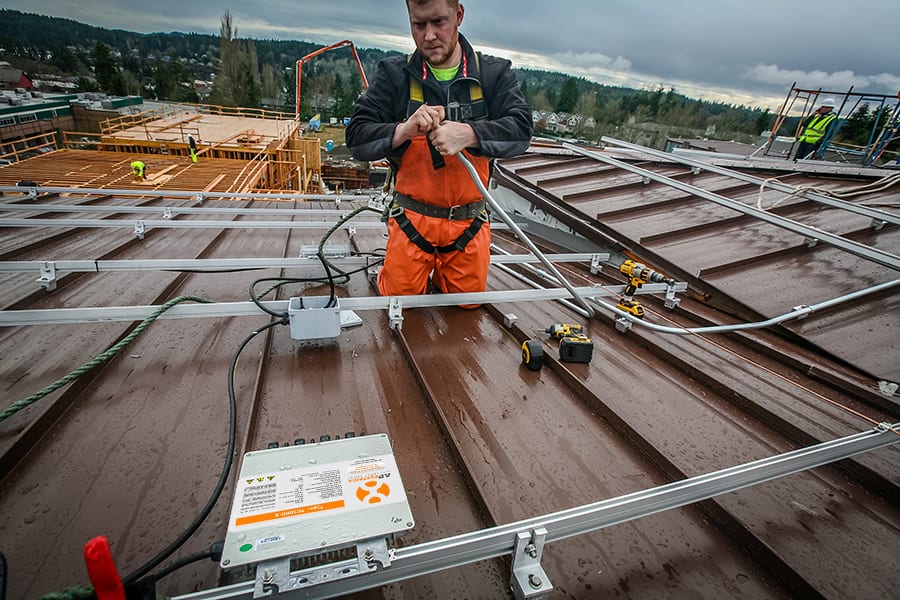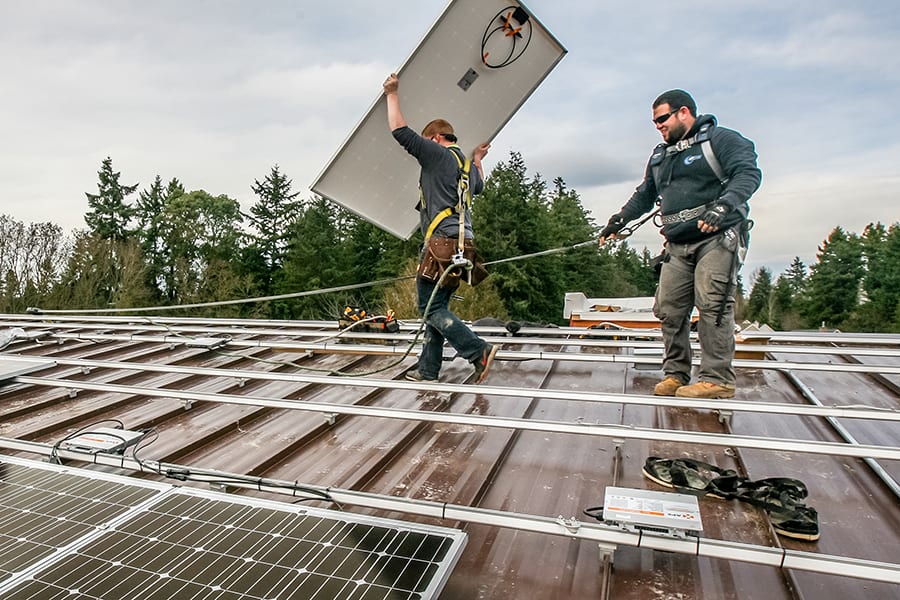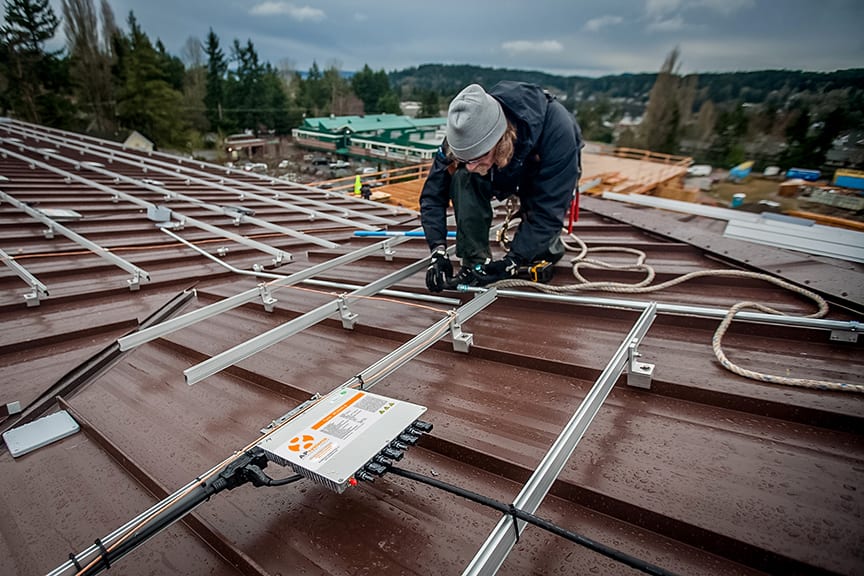Condos, apartments, townhomes – three flavors of multifamily construction, each with its own challenges for reaping the power, and financial benefits, of solar investment.
Asani development company is tackling all three at once at Grow Community on Bainbridge Island, across Puget Sound from Seattle.
On buildings dubbed the Salal, the Juniper and the Elan, now complete in the project’s expansive second phase, solar arrays will benefit both homebuyers and renters alike.
One roof apiece, with many beneficiaries beneath.
“Our investors said, ‘let’s go for it,’” said Greg Lotakis, Asani president and Grow Community project manager. “Without their desire to be the largest solar community in Washington, and wanting to plant the solar flag in the ground, we wouldn’t be doing this. Without their support, it wouldn’t be possible.”

The Salal condominiums, with 12 units spread over three stories, is effectively a “community solar” project on a rooftop. Solar was included in the purchase price – no buyer option – and incentives from the State of Washington will be apportioned equally among condominium owners. Each will own a one-twelfth interest in the array.
Asani worked with state officials and the local utility provider to craft a program that satisfies the complicated provisions of Washington law.
The opening was a provision allowing common use of single roof for solar in multifamily buildings. Asani banked on prospective buyers seeing shared solar as a good investment as they bought their condo units, one that promised annual paybacks while lowering operational costs of their building through solar harvest.
Solar was designed into the Salal building. A single production meter monitors total system output, while 12 sub-meters track consumption in individual units for utility billing.
Buyers are rolling the cost of solar, about $15,000 per unit, into their mortgages to take advantage of low interest rates at the time of purchase.
“We wanted it very clean and divisible by all the owners,” Lotakis said. “I think it would be pretty difficult for six, 10, 12 people to come together and agree upon how the system would work after the fact. This gave us a chance to just deliver it.”
Lotakis expects the 44kW array to produce about $1,500 in incentives per unit annually – cumulatively much higher than the state’s $5,000 cap on incentives for a single-family residence.
Next door at the 12-unit Juniper apartment building, the 44kW rooftop array is similar but the equation is different. Renters will enjoy the benefits of solar production through net-metering, but not the annual state solar rebate. That will go to the building’s single owner, and will max out at the state’s $5,000 cap. The Juniper building array includes APsystems YC1000 true 3-phase microinverters.
The two-story Elan townhomes presented the most straightforward challenge. Individual 6-9kW solar packages are offered for each section of the common roof. No modules will cross the “virtual lot lines,” making each system self-contained within the owner’s patch of rooftop. Three systems have been installed so far, including APsystems YC500A microinverters.
GROWING NEIGHBORHOOD SOLAR
From project inception, Asani set out to build the most environmentally friendly development possible.
Relentless sourcing of renewable materials and low-impact fixtures, and close connection to the island’s town center, have positioned Grow Community in the marketplace for healthy lifestyle-conscious buyers.
The project’s first phase is noted for its shared pea-patch gardens and winding footpaths through close-set homes. The second and third phases are oriented around a woodland grove and open greenway.

The project has earned recognition in national magazines and won awards from local and national homebuilder associations. It is only the second planned community in North America to be certified under the rigorous One Planet Living standards.
Grow’s first phase of 23 detached units sold out immediately, and every homeowner chose to add the solar package.
Asani has also showcased Made In Washington components to support the state’s solar industry.
Modules at the Salal are by Itek Energy of Bellingham, WA, while the Juniper and Elan arrays include APsystems microinverters manufactured and distributed by Blue Frog Solar of nearby Poulsbo.
Using a mix of in-state and out-of-state components allows Asani to achieve different price points for buyers while optimizing local incentives where possible.
Lotakis cautions that Grow Community’s multifamily solar program relies on particularities in Washington law. Multifamily programs elsewhere would face their own challenges, although he believes Grow offers a useful model for developers nationwide to consider.
With the Salal building only recently certified for occupancy, new residents have no comparative data on their energy savings. But the solar component was attractive, as it has been to buyers throughout the three-neighborhood, 142-home project due to be completed in late 2017.
“Solar was a factor,” one new resident said, “along with a development that encourages a sense of community.”
Between the federal tax credit and annual rebates from the state, Lotakis said, owners buying into the Salal condominiums could have their share of the common array paid off within five years.
“And because they’ve rolled the cost of solar into their mortgage, they don’t really see it,” he said. “Those production checks will be like a dividend.”

 Vegas, Here We Come!July 22, 2025 - 11:40 pm
Vegas, Here We Come!July 22, 2025 - 11:40 pm Meet Solar PupAugust 7, 2025 - 5:57 am
Meet Solar PupAugust 7, 2025 - 5:57 am APsystems Featured in Solar Builder: Leading the Charge on AI in SolarAugust 7, 2025 - 6:21 am
APsystems Featured in Solar Builder: Leading the Charge on AI in SolarAugust 7, 2025 - 6:21 am TEDDY Talks Takes Scottsdale: Two New Episodes Live!August 7, 2025 - 5:53 am
TEDDY Talks Takes Scottsdale: Two New Episodes Live!August 7, 2025 - 5:53 am Review APsystems & Win a $50 Starbucks Card!August 4, 2025 - 2:35 am
Review APsystems & Win a $50 Starbucks Card!August 4, 2025 - 2:35 am



APsystems helps Extend the Day bring solar to kids in developing nations
/in General News/by APsystems TeamAPsystems engineers assisted in the design of small, personal-sized lights, now being distributed to kids and families in remote villages in Kenya, Bangladesh, Bolivia, Myanmar and Namibia.
The lights allow students to study in the evening, dramatically changing their educational experience and opportunities.
Seattle-based Extend the Day was founded by Andrew Lonseth, APsystems President for USA Operations, and his daughter Jo, who saw the opportunity to improve lives through personal-scale solar during their global travels.
The clean-energy lights have a secondary benefit of eliminating the health hazards associated with noxious kerosene-burning lamps in homes.
“My eyes don’t burn anymore when I read,” a Kenyan student told Jo Lonseth recently. The youth now hopes to become an electrical engineer.
“Here he was in the middle of nowhere, and the light has changed his path,” Jo told Bainbridge Island Magazine.
Read the whole story here.
Click here for more information about Extend the Day.
APsystems SPI 2016 Presentation Schedule
/in Events, General News, Trainings/by APsystems TeamAPsystems Exhibits at SPI 2016 – Sept 12-15
/in Events, General News/by APsystems TeamLook for our enhanced, interactive booth 659, where we’ll be offering APsystems product training, hands-on demonstrations, and great promotional giveaways.
We’ll have the full line of APsystems advanced microinverters on display, including the powerful new YC500i with EnergyMax™ and the ArrayApp all-in-one mobile installer tool.
Email sales@APsystems.com to set up a meeting with a team member, or just drop by and find out why APsystems is the global leader in next-generation microinverters for solar PV applications.
APsystems microinverters powering multifamily solar at Grow Community
/in Article, Case Studies/by APsystems TeamCondos, apartments, townhomes – three flavors of multifamily construction, each with its own challenges for reaping the power, and financial benefits, of solar investment.
Asani development company is tackling all three at once at Grow Community on Bainbridge Island, across Puget Sound from Seattle.
On buildings dubbed the Salal, the Juniper and the Elan, now complete in the project’s expansive second phase, solar arrays will benefit both homebuyers and renters alike.
One roof apiece, with many beneficiaries beneath.
“Our investors said, ‘let’s go for it,’” said Greg Lotakis, Asani president and Grow Community project manager. “Without their desire to be the largest solar community in Washington, and wanting to plant the solar flag in the ground, we wouldn’t be doing this. Without their support, it wouldn’t be possible.”
The Salal condominiums, with 12 units spread over three stories, is effectively a “community solar” project on a rooftop. Solar was included in the purchase price – no buyer option – and incentives from the State of Washington will be apportioned equally among condominium owners. Each will own a one-twelfth interest in the array.
Asani worked with state officials and the local utility provider to craft a program that satisfies the complicated provisions of Washington law.
The opening was a provision allowing common use of single roof for solar in multifamily buildings. Asani banked on prospective buyers seeing shared solar as a good investment as they bought their condo units, one that promised annual paybacks while lowering operational costs of their building through solar harvest.
Solar was designed into the Salal building. A single production meter monitors total system output, while 12 sub-meters track consumption in individual units for utility billing.
Buyers are rolling the cost of solar, about $15,000 per unit, into their mortgages to take advantage of low interest rates at the time of purchase.
“We wanted it very clean and divisible by all the owners,” Lotakis said. “I think it would be pretty difficult for six, 10, 12 people to come together and agree upon how the system would work after the fact. This gave us a chance to just deliver it.”
Lotakis expects the 44kW array to produce about $1,500 in incentives per unit annually – cumulatively much higher than the state’s $5,000 cap on incentives for a single-family residence.
Next door at the 12-unit Juniper apartment building, the 44kW rooftop array is similar but the equation is different. Renters will enjoy the benefits of solar production through net-metering, but not the annual state solar rebate. That will go to the building’s single owner, and will max out at the state’s $5,000 cap. The Juniper building array includes APsystems YC1000 true 3-phase microinverters.
The two-story Elan townhomes presented the most straightforward challenge. Individual 6-9kW solar packages are offered for each section of the common roof. No modules will cross the “virtual lot lines,” making each system self-contained within the owner’s patch of rooftop. Three systems have been installed so far, including APsystems YC500A microinverters.
GROWING NEIGHBORHOOD SOLAR
From project inception, Asani set out to build the most environmentally friendly development possible.
Relentless sourcing of renewable materials and low-impact fixtures, and close connection to the island’s town center, have positioned Grow Community in the marketplace for healthy lifestyle-conscious buyers.
The project’s first phase is noted for its shared pea-patch gardens and winding footpaths through close-set homes. The second and third phases are oriented around a woodland grove and open greenway.
The project has earned recognition in national magazines and won awards from local and national homebuilder associations. It is only the second planned community in North America to be certified under the rigorous One Planet Living standards.
Grow’s first phase of 23 detached units sold out immediately, and every homeowner chose to add the solar package.
Asani has also showcased Made In Washington components to support the state’s solar industry.
Modules at the Salal are by Itek Energy of Bellingham, WA, while the Juniper and Elan arrays include APsystems microinverters manufactured and distributed by Blue Frog Solar of nearby Poulsbo.
Using a mix of in-state and out-of-state components allows Asani to achieve different price points for buyers while optimizing local incentives where possible.
Lotakis cautions that Grow Community’s multifamily solar program relies on particularities in Washington law. Multifamily programs elsewhere would face their own challenges, although he believes Grow offers a useful model for developers nationwide to consider.
With the Salal building only recently certified for occupancy, new residents have no comparative data on their energy savings. But the solar component was attractive, as it has been to buyers throughout the three-neighborhood, 142-home project due to be completed in late 2017.
“Solar was a factor,” one new resident said, “along with a development that encourages a sense of community.”
Between the federal tax credit and annual rebates from the state, Lotakis said, owners buying into the Salal condominiums could have their share of the common array paid off within five years.
“And because they’ve rolled the cost of solar into their mortgage, they don’t really see it,” he said. “Those production checks will be like a dividend.”
APsystems featured in Solar Builder’s new Rooftop Report
/in General News, Press Coverage/by APsystems TeamSolar Builder Magazine’s new “Rooftop Report” is out, featuring APsystems advanced microinverter technology.
APsystems Director of Engineering Christopher Barrett contributes “Get Connected: Data Monitoring in a Wireless (and sometimes wired) World,” an in-depth look at the challenges of gateway data collection in the home solar environment.
Also look for the article “Time Hacks for Installing MLPE,” features labor-saving tips and tricks for solar installers, and a report from Solar Builder’s Chris Crowell on the rapid-shutdown features built into the APsystems microinverter platform.
Find the “Rooftop Report” online here, and look for hard copies bundled with the next issue of Solar Builder Magazine, and distributed at the upcoming Solar Power International conference in September.
APsystems Launches INSTALLER VIDEO TRAINING Series
/in General News, Trainings, Video/by APsystems TeamAPsystems microinverters are unparalleled for speed and ease of installation.
The new online video training series from APsystems guides installers step by step through the fast, hassle-free installation and setup of the flagship YC500 microinverter.
The 12-part series covers fundamentals, tips and best practices for professional installation and system registration.
Topics include
* Installation preparation and safety
* Microinverter rooftop layout
* Cabling, connections and grounding
* Energy Communication Unit gateway basics
* EMA App mobile installer tool and much more.
The video series is designed for registered, professional solar installers, and complements our online training webinars, technical manuals and other support resources. To find out how to register as an APsystems installer, visit us here.
Each video is hosted by Christopher Barrett, Director of Engineering and Technical Services for APsystems USA. The entire series runs about 24 minutes, with installments viewable individually or in a single video.
Here’s a look at the first 3 videos in the series. You can view these and other APsystems videos on our YouTube channel http://youtube.com/APsystemsSolar or here on our website.
APsystems introduces YC500i microinverter with EnergyMax™ designed for high-output PV modules
/in General News, Press Releases/by APsystems TeamFOR IMMEDIATE RELEASE
SEATTLE – APsystems extends its advanced microinverter line with the new YC500i with EnergyMax™ power handling and integrated ground, now available in North America.
EnergyMax™ technology allows the dual-module unit to produce 274 watts peak output per side (548W total), an almost 10 percent increase in peak power output over conventional microinverters to harvest the power of today’s high-output PV modules.
“The new generation of solar modules demand a microinverter built to handle dramatic increases in power and output,” said Andrew Nichols, senior vice president of sales, APsystems USA. “With EnergyMax™ technology, we’re able to match the advances in module output capacity and offer higher rates of energy production to customers.”
The YC500i microinverter builds on the same advanced, FPGA chip-based platform as the popular YC500A flagship model. EnergyMax™ technology developed by APsystems maximizes the inverter’s power output for higher energy harvest across the solar array.
The YC500i utilizes a trunk cable, offering installers an alternative to the daisy-chain design of APsystems YC500A microinverters. This provides a solution for installers who favor trunk cable architecture as well as markets where regulatory bodies prefer an integrated ground.
“APsystems has always endeavored to provide flexibility and choice to our installers,” said Chris Barrett, director of engineering and technical services. “Some of our installers have experience utilizing a trunk cable architecture and the YC500i gives them that option in addition to our very popular daisy chain design.”
The YC500i is now available for order through APsystems U.S. distribution channels. Email sales@APsystems.com for ordering information.
Information on the complete APsystems solar microinverter line can be found at www.APsystems.com.
APsystems exhibiting at BriteStreet Solar Expo, July 27 in CO
/in Events, General News, Trainings/by APsystems TeamJoin APsystems at the first-ever BriteStreet Solar Expo, July 27 in Denver, Colo.
Installers can earn up to nine NABCEP credits through this informative, hands-on training event complimented with food, vendor booths and activities.
APsystems will be among more than a dozen leading solar manufacturers offering product demos, promotions and giveaways. We’ll showcase the new YC500i microinverter with EnergyMax, designed to harvest the power of today’s high-output modules, as well as the dynamic ArrayApp all-in-one mobile installer tool for fast system registration and commissioning.
The daylong event also promises a Happy Hour, good food and live music. Don’t miss it!
The BriteStreet Solar Expo runs 8 a.m. to 5:30 p.m. on July 27th.
RSVP and get more information at www.BriteStreet.com.
Join APsystems at Intersolar North America – July 12-14
/in Events, General News/by APsystems TeamAPsystems is gearing up for an incredible summer with exciting new innovations, tools to simplify your solar installations and an unprecedented rebate. Join us at Intersolar to learn more.
APsystems builds up EMEA sales and support team
/in General News, Press Releases/by APsystems TeamAPsystems has solidified its strong market position in the Europe, Middle East a region with key appointments in sales and support.
Cathia Younsi has been named Sales Regional Director Western/South, expanding the APsystems footprint in residential and commercial segments with specific focus on the France, Switzerland, Italy and Portugal markets. She brings over 15 years of sales management experience in global energy and industrial groups including Engie, Suez and Siemens before joining the solar industry with Unisolar other leaders of the industry.
Aymeric Chollet joins as Sales Manager Western, to focus on channel development with T1 installers in France and Switzerland. Jean Christophe Homar, bringing senior technical sales expertise from 20 years at Schneider Electric, remains Sales Manager Middle East/Africa, focusing on opportunities in South Africa, Morocco, Turkey and Jordan.
Reda Kaismoune has been named Product Trainer West/South and regional technical advisor. Kaismoune brings strong training program design and delivery experience from solar companies such as Sunpower corporation, where he spent seven years.
Chris Pitts starts as Sales Manager Benelux and UK. Chris comes from Bosch Inverter where he was UK Sales Manager for the solar division.
“Under the leadership of Olivier Jacques, Senior VP and MD for the EMEA region, our team will continue to build to cover the dynamic EMEA region and bring top class expertise for APsystems in the market,” said Maxime Boiron, senior marketing director for the APsystems EMEA regions “We are establishing a sustainable organization in the EMEA region and have currently several open positions in customer support, training and sales to provide our growing customer base the best possible services.”
APsystems EMEA maintains offices in Rotterdam, Netherlands, and in Lyon, France.